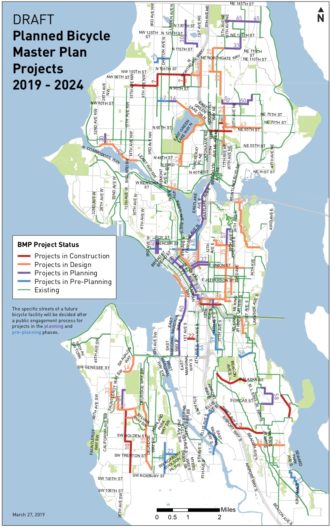
26 miles of bike facilities are gone completely, and another 27 are at risk. That’s the harsh reality of the latest iteration of the Bicycle Master Plan Implementation Plan (the “Bike Plan Plan”).
The result is what could be a more transparent bike plan the city has put forth in the years since voters approved Move Seattle, but it’s not visionary. The latest plan officially abandons the goal of keeping the 20-year Bicycle Master Plan on track for completion and will leave massive gaps in the citywide bike network even if every project included is constructed on schedule. And given our recent experience with Mayor Jenny Durkan cancelling the 35th Ave NE bike lanes, that’s hardly a sure thing.
SDOT will present this plan to the City Council Transportation Committee 2 p.m. today (Tuesday). Stay tuned for updates from that meeting or watch via Seattle Channel.
By the end of 2016, the 20-year Bicycle Master Plan was 28% complete (it started at 22% in 2013). One year later, it was 29% complete. One percent per year is dismal progress. It’s hard to imagine how the project list in this latest update puts the city within 5 years of achieving Vision Zero or on track to fulfill its ambitious Climate Action Plan goals.
There is one measure, though, where Seattle is making huge progress: Ridership. And that’s the most important one. The city’s annual bike counts saw an incredible 12% increase in 2017-2018, almost certainly powered by the boom in private bike share services coupled with significant bike route improvements like the 2nd Ave bike lane extension and the Westlake Bikeway. This is amazing, and despite all the other frustrations in this update, let’s not lose sight of this success. Seattle’s efforts to help more people get around by bike are working. We need city leadership to build on this success, not fight it.
In addition to the big bike network cuts, the plan highlights another 27 miles “with known risks,” which could be due to partnership dependencies (such as project where Sound Transit also has a say), where Federal funding is unknown or where the politics could be sticky (car parking!).
But as easy as it is to get angry or discouraged when looking through the latest plan, at least advocates can now see what the city is actually planning rather than being repeatedly blindsided by disappointing setbacks and cuts. The new plan may also provide a much-needed solid step for bike and safe streets advocates to stand on after years of what has felt like free fall. Because this is now Mayor Durkan’s plan.
This doesn’t mean people should just accept this plan and stop fighting to get important projects back. It is devastating to see so many of the Bike Plan’s goals abandoned like this. It is very frustrating to see that the city does not plan a single connection between Rainier Valley and downtown before the end of this levy, for example, and deletions like that are worth fighting to restore. But at least now most of those projects that just sort of vanished from the radar have reappeared somewhere. It may be in the delete pile, but at least you now have a place to start working again. (Erica Barnett at the C Is For Crank says she combed through the project lists and found 11 projects that seem to have disappeared between the 2017 and 2019 plans).
There are many ways to measure bike progress, and the city is doing poorly by most of them. If you focus on mileage, at best, the city is currently building less than half of what is needed each year to keep the 20-year Bicycle Master Plan on track. Since the City Council unanimously passed the master plan in 2014, The city has never even gotten close to building the 24 miles of bicycle facilities per year that would have been needed on average to reach that goal over 20 years. To reach the less ambitious goal laid out by the Move Seattle Levy (for half the plan to be complete by the end of the levy, including the miles previously constructed), the city would need to build about 20 miles of bicycle facilities every year now through the end of the levy in 2024. This latest plan shows that they are not going to try to do that, aiming for more like 10 miles per year if every project is constructed on schedule.
The other half was supposed to come from a mix of paving project partnerships (like 35th Ave NE, which has been cancelled), Federal funding that either SDOT has not been successfully applying for or has otherwise not come through (Trump’s administration isn’t exactly going out of its way to fund Seattle’s grant requests), and the planned “multimodal corridor” projects that have been slashed heavily. The price per mile for bike lanes, especially downtown, are quite a bit higher than the average cost assumed in the levy.
But bike facility mileage is not necessarily the most important measure, since bike network connections are the city’s real issue. A mile in a low-density part of town is hardly comparable to a mile downtown, for example. So if the city were going to miss their mileage goals because they bit off ambitious, game-changing and expensive sections instead, that could be a very worthy trade-off. But that’s not really what’s happening, either. The cut list includes many of those high-impact and difficult bike lanes, the kinds of projects that we need most. Rainier Ave between at least Mount Baker Station and Dearborn tops the list, for sure, but also Beacon Ave and N 40th Street and many others that ended up in the scrap pile:
But even more concerning is that the bulk of the remaining high-impact projects are included under projects “with risks” or “with known risks”:
Only 36 miles of bike facilities are considered at “low risk,” and only 30 of those miles are funded through construction:
Organizing projects by “risk” is really interesting. On one hand, it’s more transparent. SDOT isn’t pretending that they don’t see ways projects could falter. They are basically daylighting concerns they previously held behind the scenes.
But on the other hand, it sure makes the rest of the levy feel very uneasy. And it gives the impression that SDOT is not fully dedicated to accomplishing even this massively reduced project list. At a time when people upset about bike lanes successfully killed them on 35th Ave NE on a purely political basis, it’s hard to have faith that the city is ready to go to bat for these difficult but important bike network connections.
And even if this list inspires advocates for bike lanes and safer streets to get organized to push each and every one of them through, is that really the best way for our city to operate? People who drive are not expected to pack City Hall to fight for a multi-million-dollar paving project in their neighborhood, those projects just happen as the regular course of SDOT business. But people who bike are expected to do so for every little 0.13-mile segment of bike lane? That’s asking an awful lot of people, many of whom already volunteered lots of time and energy to creating this plan and passing the levy to fund it. I mean, I’m sure people will do it, but I wish city leaders would challenge advocates with a more empowering goal than just protecting the remaining scraps of a bike plan they already worked to pass.
And that leads into my biggest issue with this plan update: Vision. Seattle has very lofty goals, and the people of this city believe in them. This plan does not inspire. It shies away from most of the hardest stuff and, even if fully completed, leaves huge parts of our city disconnected. It does not improve equitable access to biking, and it does not hold the promise of making game-changing connections to seriously increase the number of people biking to get around. It is a diminished list of projects that will be steps in the right direction, but won’t be nearly enough.
This also feels like an inflection point for Seattle bicycle and safe streets advocacy. There is a big new near-term workload to accomplish that is going to need a lot of new voices and leaders. That could mean you. SDOT’s Bicycle Program is also in the midst of huge staff turnover, including the retirement of longtime program leader Sam Woods, a true legend. So Seattle needs ambitious and creative professionals to fill those roles. Keep a lookout for job listings.
But this is also the time to start planning for how the city can close gaps so wide that even the largest transportation levy in city history falls so short. I don’t know what that looks like, but now is the time to start the ground work to make it happen.

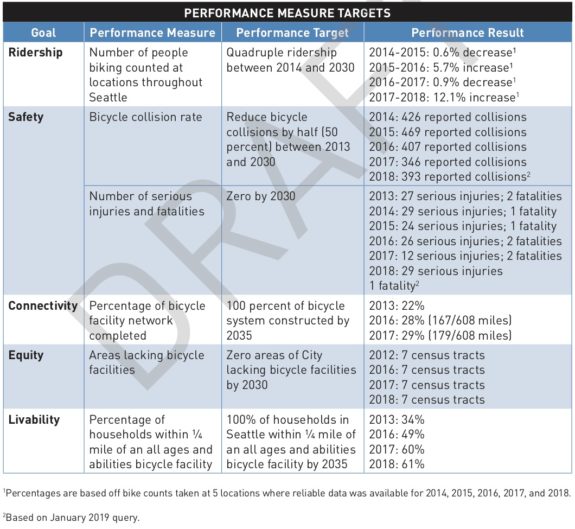
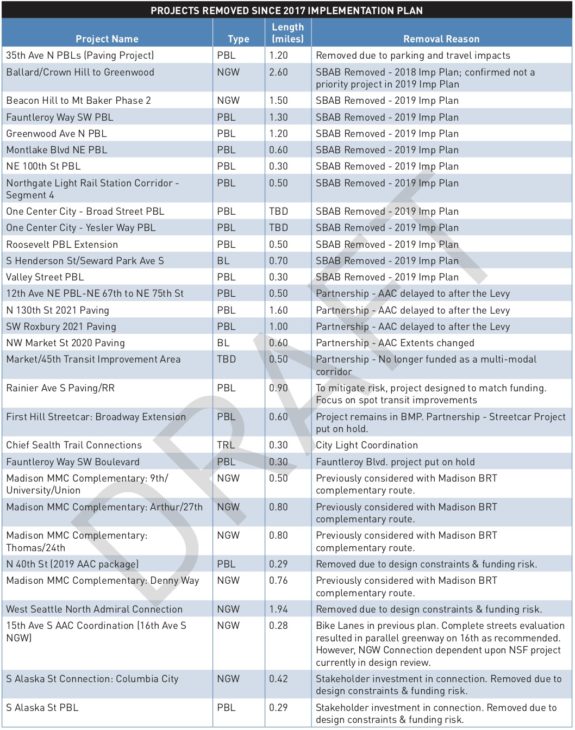

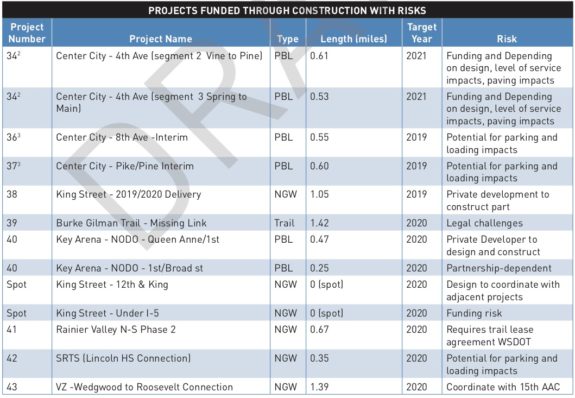
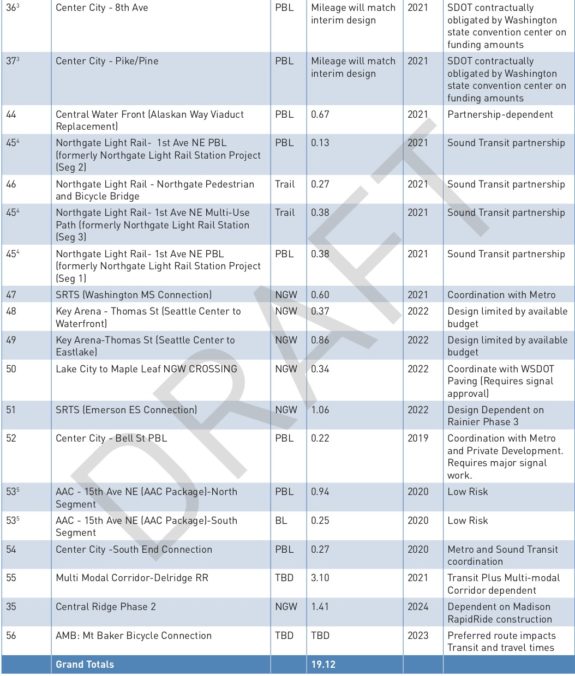
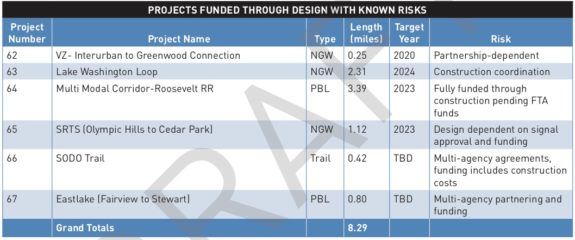
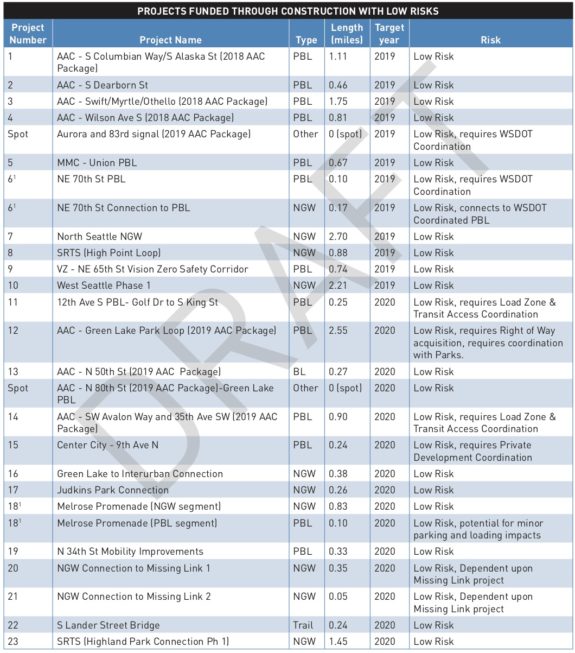
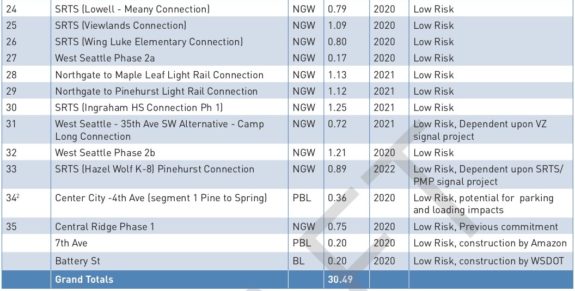
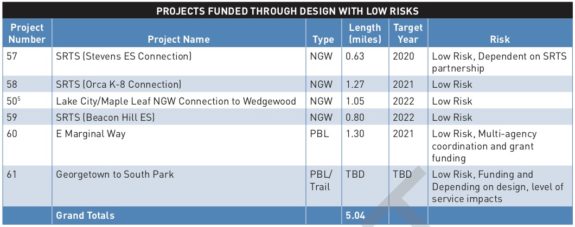







Comments
26 responses to “SDOT and Mayor Durkan release more transparent, less visionary bike plan”
Organizing by risk sounds like a way of telling opponents which projects the city won’t be “vigorously” defending
It’s good to know now that there won’t be a complete coherent bike path along the waterfront, ever. Awesome, glad they spent the money on the tunnel.
As ridiculous as the waterfront missing link is, the reduction of Rainier to “transit spot improvements” seems like a kick to the junk and stab in the back for a neighborhood that desperately needs investments in safety.
The mayor loves to talk about equity, vision zero, and sustainability but her policies appear to focus on inequity, more murders by cars, and burning fossil fuels.
Hi Southeasterner,
The number of dollars for bike projects didn’t change. The only thing that changed was the reality of completing the projects. Murray/Kubley wanted to be re-elected, so they promised the moon.
A couple years later, and the moon proves to be extremely hard to procure. But bottom line, I think we are better off by dealing with stone cold reality than the fantasies that Murray/Kubely have been selling.
Yesler,
Fully understood that the previous administration couldn’t complete basic math but still no excuse for Durkan to not prioritizing safety improvements on Rainier in her revised budget, especially so shortly after stating her commitment to Rainier during her state of the city address.
If only we had the Moon, instead of the Durkan.
Acknowledging Tom’s point about vision, this doesn’t cut one thin dime from bike projects. 100% of the funding remains, it is just redirected to projects SDOT believes can be completed.
Ed Murray and Scott Kubley vastly, vastly overpromised what was possible, and not just on bike projects. For example, we’ll be lucky if we get half the bus rapid transit that was promised. But there is no possible way the all bike projects can be completed with the existing budget. That means the existing projects needs to be prioritized. That’s just stone cold math. It is good politics to over promise. Murray got elected mayor and Kubley got a cushy job in private industry, despite his resume of absolute non-performance. So it was a win-win for them. Not so much for the citizens.
Again, you can argue that the priorities should be different. That’s fair. But the amount of money is still the same. The only thing that has changed is the city acknowledging that we can’t pay for all the promises made by a previous administration. I find sober reality a refreshing change to wishful thinking of the Murray cabal.
“The only thing that has changed is the city acknowledging that we can’t pay for all the promises made by a previous administration. I find sober reality a refreshing change to wishful thinking of the Murray cabal.”
What? We voted to pay for the improvements in MOVE Seattle. If the money was never adequate why not give us, the voters, the opportunity to vote for a further incremental tax to bridge the gap? Why is the automatic reaction to cut back on the projects we voted for to align with the revenue available?
It’s not fair to the citizens of Seattle to not even give us that opportunity to bridge the gap for the city we want.
It’s going to require a monumental undertaking to convince Seattle voters to approve a new levy in 2024, let alone an interim levy to save an overpromised levy-in-progress, even with myself, who is typically pro-levy.
People don’t see that labor and material costs for construction have skyrocketed, what they see is that the levy tax doubled and a lack of progress.
While I’m no fan of Durkan, she’s in a bad position to have to start slashing projects to meet budget for a bungled levy that she inherited and this may end up being her version of the snowpocalypse that cost Nickels his reelection. That said, I’m having trouble feeling sorry for her for cancelling 35th and punting on the Missing Link, despite no valid reason for either.
Except on 35th, it wasn’t about funding at all. It actually cost more to cancel the bike lanes. The administration is clearly not interested in (and perhaps actively against) bike infrastructure and is looking for ways to scale it back and cancel projects. This document lays the groundwork, even if the funding is supposedly maintained. How many “at risk” projects will be delayed or cancelled once most of the funds are spent on design, community outreach, mediation, and change orders?
I live near 35th. Many, many, many neighborhoods nearby got their streets resurfaced with no outreach, community meetings, delays until winter, more delays because hey now it’s winter, mediation processes. Only after that was all done did we say “oops, prices have gone up in the last few years, we can’t paint some yellow lines and remove a lane of parking”. Instead we’ll put the paint in slightly different places, remove some parking and give the plastic post money to a friend of the mayor.
The whole reason that project was even planned was that it would reduce expenses for bike infrastructure by leveraging repaving that was happening anyway. And the bike infrastructure would double as road narrowing to control weaving and speeding and reduce crossing distances. Don’t paint a line just to scrape it off and move it a few years later. Don’t fix a sewer drain just to move it a few years later. Rather evaluate the best place to put those design elements at the time of construction.
Sabotaging that process to then claim safety features cost too much is just carrying so many buckets of oil to keep the pipelines flowing.
I agree with both of you. That is what is ridiculous about the 35th Avenue decision. There are a number of good reasons why it makes sense to cancel a bike project. Cost is one. Another is if it conflicts with possible improvements to transit. But there is simply no good reason to cancel the 35th street project. It won’t make things safer. It won’t save money. It won’t help transit. In all respects, it is a very stupid decision.
What do these cancellations mean? I see things like 130th – partnership AAC delayed until after levy. Does this mean they will just go ahead with the street paving and forget about the bike facilities? Or does it mean the paving has been delayed, so they dropped it from the plan. (I know 130th was on the docket a few years ago, before it got tied up in light rail planning.)
Paving is dropped. Almost everything got cut back. “Overpromise and underdeliver.” It was the Kubly Way.
12% 2017-2018 increase in bike ridership is actually reading a false economy. That increase almost certainly is LimeBike ridership — which is financially-dubious at best. The hard reality is the Bicycle Master Plan is not increasing ridership or making bike riding safer. Sorry if this offends, but please look at the numbers objectively and don’t shoot the messenger.
Wait what? How does bike share not count towards an increase in ridership? If Lime and Uber’s bikes were to disappear tomorrow, you would have a non-zero amount of people that would take up riding, having dipped their toes.
How is the BMP not increasing ridership or making it safer? Building bike infrastructure 100% makes biking safer, which has a direct impact on the increase of ridership.
The only reason your comment offends is because it’s a bunch of weak opinions masquerading as facts, despite absolutely nothing to back them up.
According to Washington State Patrol accident records, auto, pedestrian and bike accidents each have at least doubled since the Roosevelt Way “protected” bike lane opened in November 2016. As for sidewalk bike rentals (“bike share” in corporate-speak), would you invest into that business model??? I love them and use them, but the costs of re-charging and re-positioning probably make the Pronto! numbers look good. I want urban bike success in Seattle. But I just don’t see it ahead on the path we are following.
“The hard reality is the Bicycle Master Plan is not increasing ridership or making bike riding safer”
We haven’t implemented the Bicycle Master Plan so how would we know?
Building one-off unconnected improvements is very different than an actual network of safe bike facilities, which we will now likely never have.
In cities where there is an actual network there is an incremental step change in ridership. As you pointed out ridership has increased [despite not having a network]. This to me says that even without adequate facilities people are still going out there and riding and with a network effect the increase will be substantial.
Level of Service Risk and Parking Risk are not project risks. A project risk is something you can’t control and don’t know for sure. Unknown geology in a tunnel or uncertain utility relocation costs are project risks.Parking and level of service are things that are both knowable and controllable. These are a statement of priorities pretending to be a statement of risk as a way to deflect responsibility. Do you ever remember the city taking a look at a turn lane project and stating that one of the project risks is the impact to bicycle and pedestrian safety. This is about priorities-the essential heart of politics.
Hear hear! Good job cutting through the bureaucratic double talk.
[…] Seattle Times, Curbed, Erica C. Barnett, Seattle Bike Blog, and The Urbanist all cover the draft update to the city’s Bike Master Plan implementation […]
Note that much more progress has been made on the bike master plan than on the pedestrian master plan. Murray-Kubly over promised. Durkan has to reset the levy. Murray-Kubly also did not well balance the intersection of the BMP with transit service. Consider two examples. North 130th Street cycle tracks may not be compatible with an ST2 Link station at NE 130th Street; the Link station should be complemented by frequent transit service connecting the Lake City and Bitterlake urban villages with bus stops. Can a cycle track and a transit transfer point on 12th Avenue South at South Jackson Street both be provided?
I agree.
But at the same time, Durkan has lost all credibility as far as bike infrastructure goes. Those are all good, sensible reasons for the cutbacks. But there is simply no good reason to cancel the 35th Street project. Cancelling it does not save money, does not make for better transit, there is no good bike alternative — it just doesn’t add up. The point is, decisions like that mean that we simply can’t trust her ability to commit to a project, which puts us back in a similar position as we were with Kubly (hoping for a reversal, or waiting for a new mayor). Speaking of which, she did reverse course when it came to picking a new police chief, maybe she will put in the bike lanes after all.
I find myself immensely curious to see a heat map of Durkan’s donors, and to compare that with the Save 35th group. Something stinks about that decision.
[…] Bike Master Plan is substantially less ambitious. ECB with more. The backlash is […]
[…] has written a strong letter of concern about the lack of bicycle network progress and SDOT’s big cuts to the bike plan for the duration of the […]